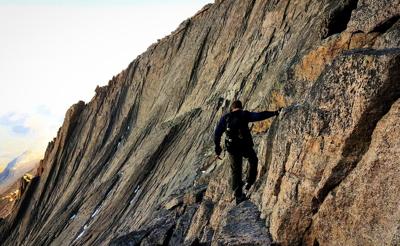Climbing to high-altitude spots around Colorado can be quite dangerous, sometimes resulting in death. Here’s a breakdown of the deadliest peaks in the state, looking at how many deaths have occurred on each peak between 2000 and 2017, according to Colorado’s 14er Initiative. Visit their Youtube page for an entire library of mountain safety videos.
We’ve also included a note about the popularity of each peak, as well as additional details when applicable. Note that while Longs Peak is by far the deadliest, a lot more people attempt to climb the mountain on an annual basis. It’s also worth noting that Longs Peak has the “easiest” rating (Read: Still a difficult climb) compared to the other peaks.
1. Longs Peak – 19 deaths
Popularity: 15,000-20,000 climbers per year
Difficulty: Class 3; 14.5 miles; 5,100 feet of gain
Notes: Located in Rocky Mountain National Park, Longs Peak also has the highest “failure rate,” meaning that a high percentage of climbers fail to reach the summit. Many often point to the number of less experienced hikers and climbers making the attempt due to the accessibility of the trailhead as the reason for this high failure rate. Remember, there’s nothing wrong with “failing” a climb during your attempt to reach the summit – turn around and try another day when it’s safer.
2. Maroon Bells – 12 deaths
Popularity: 1,000 to 3,000 people per year
Difficulty: Varies – Standard route to visit both peaks in one go includes a Class 5 Traverse. If you’re doing the combo route including the Bells Traverse, you’re looking at 9.5 miles and 4,850 feet of elevation gain with up to Class 5 climbing.
Notes: This is actually two peaks, though numbers related to popularity and deaths tend to look at the peaks as one.
3. Capitol Peak – 9 deaths
Popularity: 1,000 to 3,000 people per year
Difficulty: Class 4; 17 miles; 14,130 feet
Notes: Capitol Peak is notorious for the “Knife Edge” portion – a part of the climb along a sharp ridgeline with extreme exposure.
4. Crestone Needle – 6 deaths
Popularity: 1,000 to 3,000 people per year
Difficulty: Class 3; 12-18 miles depending on trailhead; 8,800 – 9,000 feet of elevation gain depending on trailhead
5. Snowmass Mountain – 5 deaths
Popularity: 1,000 to 3,000 people per year
Difficulty: Class 3; There’s a 22-mile route with 5,800 feet of elevation gain and a 9-mile route with 4,500 feet of elevation gain.
Notes: Not a mountain that’s at Aspen ski resort.
6. Little Bear Peak – 3 deaths
Popularity: 1,000 to 3,000 people per year
Difficulty: Class 4; Varies greatly.








(0) comments
Welcome to the discussion.
Log In
Keep it Clean. Please avoid obscene, vulgar, lewd, racist or sexually-oriented language.
PLEASE TURN OFF YOUR CAPS LOCK.
Don't Threaten. Threats of harming another person will not be tolerated.
Be Truthful. Don't knowingly lie about anyone or anything.
Be Nice. No racism, sexism or any sort of -ism that is degrading to another person.
Be Proactive. Use the 'Report' link on each comment to let us know of abusive posts.
Share with Us. We'd love to hear eyewitness accounts, the history behind an article.